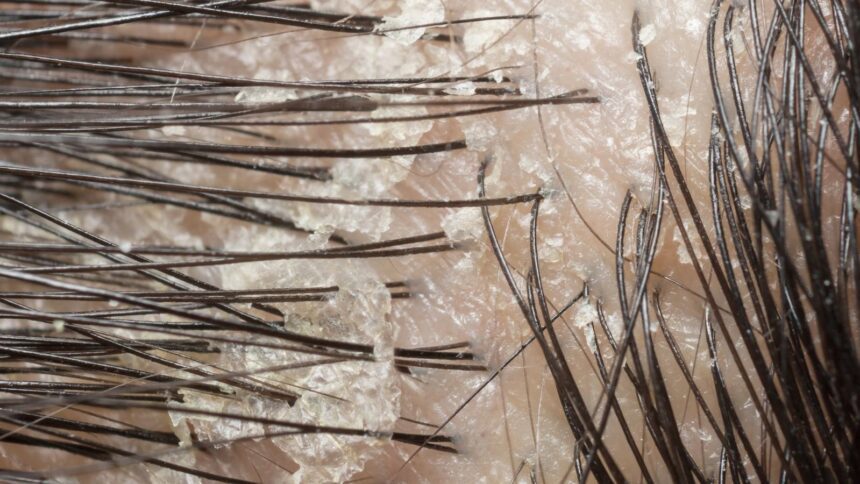Dandruff, a commonplace yet often misunderstood condition, is the subject of our scrutiny today. This ubiquitous issue can plague individuals for years, pushing them into a seemingly never-ending cycle of remission and recurrence.
The market offers a wide range of solutions, from shampoos and topical creams to zinc, selenium, and coal tar treatments.
However, these remedies are not without their potential side effects, including hair loss, thinning, graying, and skin rashes.
Unraveling the Dandruff Mystery: Seborrheic Dermatitis
To take aim at dandruff effectively, one must first grasp the crux of the matter. A primary perpetrator behind dandruff is a condition known as seborrheic dermatitis.
In layman’s terms, dermatitis refers to skin inflammation, and ‘seborrheic’ is tied to sebum production. Sebum, the oil secreted by our skin, plays a pivotal role in this enigma that is dandruff.
The Unseen Ecosystem: Microbes and Skin Health
A closer look at the sebaceous glands, the sebum factories of our skin, reveals an intriguing interaction with a very specific type of fungus.
This fungus thrives on lipids, or fats, which are primarily found in the sebum. It’s worth noting that while a vast majority (99%) of all microbes on our bodies are bacteria, the remaining 1% consists of yeast, fungus, and other microorganisms. This dandruff-causing fungus is particularly resilient, resisting elimination by antibiotics, much like another yeast or fungus known as Candida.
Candida, Dandruff, and Inflammation: Connecting the Dots
Antibiotic usage often precipitates Candida flare-ups. The link between Candida and dandruff hinges on the inflammatory response induced by the fungus. This inflammation results in the characteristic flaky skin associated with dandruff.
Concurrently, there’s an uptick in sebum production by the sebaceous glands, supplying the fungus with ample nourishment to thrive. This phenomenon is especially pronounced during teenage years and tends to re-emerge in individuals over the age of 50.
The Confluence of Health Conditions: Dandruff, PCOS, and Insulin Resistance
The plot thickens with the observation that both polycystic ovarian syndrome (PCOS) and insulin resistance show a higher incidence of dandruff.
A topical cream containing metformin, commonly prescribed for insulin resistance and diabetes, has been found to alleviate not only dandruff but also acne, psoriasis, and rosacea.
An Alternative Approach: Berberine
The success of metformin opens the door to potential alternatives with fewer side effects, such as berberine.
Indeed, a berberine cream has shown promise in mitigating dandruff owing to its antifungal properties.
Insulin Resistance: The Underlying Thread
Piecing together these disparate elements leads us to a singular commonality: insulin resistance. Elevated insulin levels, a hallmark of insulin resistance, spur the production of androgens.
These androgens, in turn, stimulate sebum production in the sebaceous glands. The excess oil serves as a veritable feast for the dandruff-causing fungus, perpetuating a vicious cycle.
Hormonal Imbalances and Dandruff
Sebum production tends to spike during certain life stages, notably adolescence and post-menopause in women.
The latter can be attributed to a drop in estrogen and progesterone levels, while androgen levels remain relatively steady. This hormonal shift may trigger dandruff outbreaks.
Metabolic Syndrome: A Linked Phenomenon
Metabolic syndrome, a condition marked by high blood pressure, elevated glucose levels, and high triglycerides and cholesterol, is yet another piece of the puzzle. Its root cause is also linked to insulin resistance, offering another clue to understanding the complex world of dandruff.
A Dietary Shift: The Power of Keto and Intermittent Fasting
Considering insulin resistance’s role in dandruff, one may find the solution in addressing this underlying issue. Two dietary strategies have shown significant promise in combatting insulin resistance: the ketogenic diet and intermittent fasting.
These methods have been adopted by many individuals who have experienced an improvement in their dandruff condition, without the use of scalp-specific remedies.
Keto: A Potential Game Changer for Dandruff
The ketogenic diet, a low-carb, high-fat diet, has been proven to help regulate insulin levels and thus can be a potent tool in managing dandruff.
By reorienting the body’s energy source from carbohydrates to fats, the ketogenic diet effectively tackles insulin resistance, one of the root causes of dandruff.
Intermittent Fasting: Breaking the Cycle
Intermittent fasting, another dietary practice gaining momentum, can also aid in managing insulin levels and thus in controlling dandruff.
By restricting eating to certain periods, the body’s insulin response can be better managed, breaking the vicious cycle of dandruff.
In Conclusion: The Path to a Dandruff-Free Future
Dandruff, while a common issue, can be a persistent and troubling condition for many.
However, understanding the intricate web of factors contributing to dandruff from sebum production and fungal activity to hormonal imbalances and insulin resistance can provide a clear roadmap to managing this condition effectively.
Adopting dietary practices such as the ketogenic diet and intermittent fasting can play a pivotal role in mitigating insulin resistance, thereby addressing one of the primary underlying causes of dandruff.
As more individuals embark on these dietary journeys, there’s hope for a dandruff-free future.
Remember, health is a journey, not a destination. Armed with knowledge and the right tools, one can navigate the path to a healthier, happier self. The battle against dandruff is just one step in this lifelong journey.
DATA:












